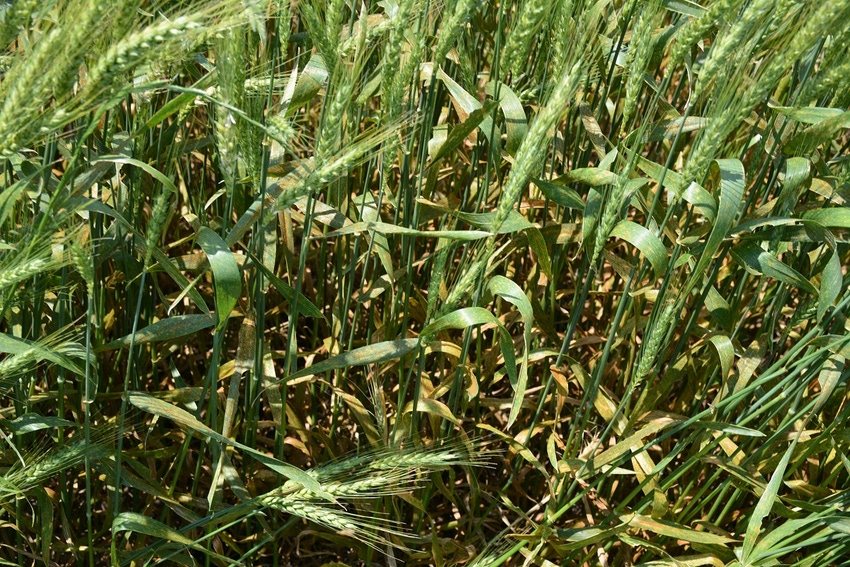July 22, 2015

Foliar fungicides have proven to be an effective tool to manage foliar diseases on wheat in Northeast Texas. They are effective against leaf rust, stripe rust, and glume blotch. The decision to apply a foliar fungicide to wheat in 2015 was one of the best management choices a grower could make.
Foliar fungicides do not enhance yields—they can only protect potential yields from loss to the rusts or glume blotch. Consequently, they are not profitable in the absence of disease.
Over the past seven years, we conducted a study on the profitability of tebuconazole on commercially grown varieties with good resistance to both leaf and stripe rust. In 2015, we compared the following varieties in both a sprayed and unsprayed scenario: USG 3120, USG 3201, SY Coker 9553, SY Harrison, Terral TV 8525, Terral TV 8861, Pioneer 25R40, and Pioneer 25R50. All of the varieties tested were soft red winter wheat varieties (SRWW).
A single application of TebuStar (tebuconazole) was applied at the rate of 4 ounces per acre. We targeted a late application at growth stages ranging from Feekes 9 (full flag leaf emergence) to Feekes 10.5.1 (flowering). A non-ionic surfactant (Preference) was mixed with the spray solution at the rate of 0.25 percent by volume. The plots were sprayed with a CO2 powered backpack sprayer in 14 gallons of spray solution per acre. Fungicide effectiveness was evaluated by measuring both yield and bushel weights of the treated and untreated wheat.
For the latest on southwest agriculture, please check out Southwest Farm Press Daily and receive the latest news right to your inbox.
Difficult growing season
The 2014/2015 growing season was difficult for Northeast Texas wheat producers. Most wheat was planted in the first two weeks of November, but dry conditions followed and many fields did not develop a complete stand until the first of December. Once the rains began in early winter, fields stayed wet for most of the growing season. A very wet April was followed by record high rainfall in May (DFW Airport reported 26 inches in May). These sustained wet conditions triggered unusually heavy stripe rust, leaf rust, and glume blotch infections.
In 2015, we measured unusually large yield and bushel weight increases in all varieties in the study when we sprayed tebuconazole. We initiated the same trial in each of three locations— Leonard, Royse City, and Howe). We averaged all three locations together, as results in each location were similar.
Summary of results
Following is a summary of our 2015 results.
Table 1 Yield in Bushels per Acre
Three Location Average (Leonard, Royse City, Howe)
Variety | Bu/A Sprayed | Bu/A Unsprayed | Additional Bushels With Fungicide |
USG 3201 | 66.7 | 46.9 | 19.8 |
SY Coker 9553 | 64.0 | 53.7 | 10.3 |
USG 3120 | 59.9 | 51.2 | 8.7 |
SY Harrison | 59.4 | 33.8 | 25.6 |
Pioneer 25R50 | 58.8 | 37.7 | 21.1 |
Terral TV 8861 | 58.1 | 32.6 | 25.5 |
Pioneer 25R40 | 57.6 | 42.3 | 15.3 |
Terral TV 8525 | 52.9 | 28.5 | 24.4 |
Average | 59.7 | 40.8 | 18.9 |
Table 2 Test Weight (Lb. /Bu)
Three Location Average (Leonard, Royse City, Howe)
Variety | Lb./Bu Sprayed | Lb./Bu Unsprayed | Increase in Test Weight (Lb./Bu) |
SY Coker 9553 | 60.5 | 58.7 | 1.8 |
USG 3120 | 59.3 | 57.9 | 1.4 |
USG 3201 | 59.1 | 54.6 | 4.5 |
Pioneer 25R40 | 58.9 | 55.3 | 3.6 |
Terral TV 8525 | 57.7 | 51.3 | 6.4 |
Pioneer 25R50 | 57.4 | 52.2 | 5.2 |
Terral TV 8861 | 56.7 | 50.7 | 6.0 |
SY Harrison | 54.3 | 48.8 | 5.5 |
Average | 58.0 | 53.7 | 4.3 |
Yield advantages
Yield increases with a foliar fungicide in 2015 ranged from 8.7 to 25.6 bushels per acre, with an average increase of almost 19 bushels per acre. The early maturing varieties (USG 3120 and SY 9553) showed a smaller increase (9.5 bushels) than the commonly grown later maturing varieties (Pioneer 25R40 and Terral 8861), which averaged a 20.4 bushel yield increase when sprayed. We suspect the later maturing varieties showed a larger yield increase when sprayed because they were exposed longer to the fungal diseases in the field.
We also observed large increases in bushel weight where tebuconazole was sprayed. We measured a smaller average bushel weight increase with the early maturing varieties (1.6 pounds) than the commonly grown later maturing varieties (4.8 pounds). Higher test weights translate to better grain prices in the marketplace.
We have been recommending an application of an inexpensive foliar fungicide (for instance, tebuconazole) at heading for several years. Some years, when foliar plant diseases are not prevalent, the fungicide application only produces a 2- to 3-bushel yield increase, just enough to cover the cost of the fungicide plus the application. However, in wet years with heavy pressure from foliar plant diseases (stripe rust, leaf rust, and glume blotch) a timely fungicide can make the difference between profit and loss when sprayed in a timely manner. The 2015 growing season was such a year.
What we actually observed was the largest responses to a fungicide treatment we have seen since we initiated this study seven years ago. Most of the local wheat acreage is planted in two varieties – Terral 8861 and Pioneer 25R40. At today’s wheat prices, the breakeven for tebuconazole (fungicide + application cost) is around 1.5 bushels of wheat. For every dollar spent on a tebuconazole application this year, we got a return of over $13. That’s an investment that every wheat producer can embrace.
You May Also Like




